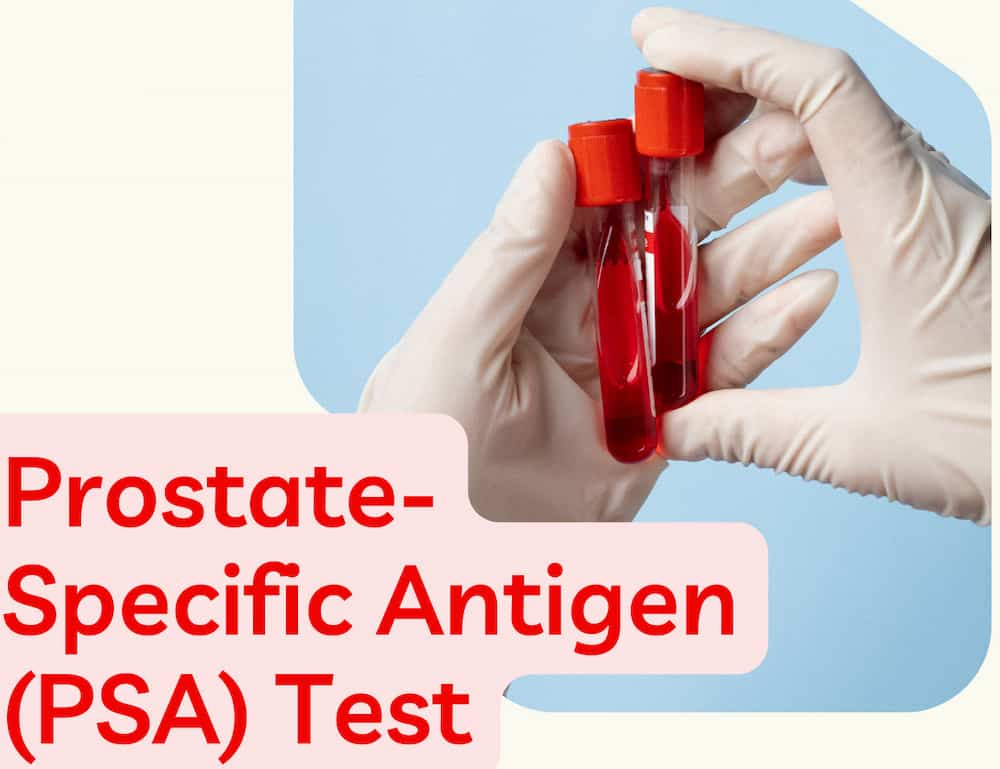Summary :
- Definition
- Physiology
- Requirements for a PSA test
- Quelle est la valeur normale de l'antigène spécifique de prostate ?
- Interprétation des résultats
- Des niveaux élevés de PSA, que faire ?
◉ Prostate-Specific Antigen (PSA) Test
PSA, or prostate specific antigen, is a protein naturally made by the prostate (both cancerous and non-cancerous prostate tissue). Its role is to thin the sperm and, in fact, facilitate the mobility of spermatozoa.
This antigen is found mainly in the semen, but it can also be detected in small quantities in the blood.
A high PSA blood level compared to normal values could be the sign of an abnormality in the prostate. It is used primarily to screen for prostate cancer.
It is measured using a simple blood sample.

◉ Physiology
The prostate is a small gland that is part of the male reproductive system. It is located under the bladder and produces fluid that is part of semen.
PSA is a molecule secreted exclusively by the prostate. It exists in the semen where it has a role in the liquefaction of the seminal coagulum. Part of the secreted PSA passes into the bloodstream at concentrations one million times lower than its prostatic concentration.
A part of the blood PSA is free (approximately 70%), the other associated with blood proteins (approximately 30%). We then speak of “free PSA” or “complexed PSA”.
Prostate tumors are pathological overgrowths of part of this organ, producing higher amounts of detectable PSA in the blood.
Note: A gradual increase in PSA levels is observed with age.
◉ Requirements for a PSA test
The assay is done on a blood test, it is not necessary to be fasting (unless your blood sample will be used for additional tests).
You will need to avoid having sex or masturbating for 24 hours before your test, as the release of semen can raise your PSA level.
5-alpha-reductase inhibitors used for the treatment of voiding dysfunction associated with benign prostatic hyperplasia reduce the PSA value by half after 6 months of treatment.
There are several prostate specific antigen assay methods for which the result varies significantly. This is why it is essential to carry out the follow-up in the same laboratory or, failing that, with the same technique.
The tests allow either the determination of total PSA, or only its free fractions (Free PSA) or bound (complexed PSA).
◉ PSA blood test levels
Laboratories measure the amount of PSA in your blood. The results of the analysis are expressed in nanograms per milliliter of blood (ng/mL) or micrograms per liter (μg/L).
High PSA levels could be a sign of prostate cancer or another condition such as prostatitis or an enlarged prostate.
Although "normal" PSA levels vary from lab to lab (the lab report should always specify the assay method used), it is generally accepted that a lower value at 4 ng/ml is normal.
- Normal : < 4ng/ml
- Suspect: 4 - 10 ng/ml
- High: > 10 ng/ml
Note: The normal PSA level varies depending on the age of the patient, but according to AFU, tables of PSA values adjusted for age have little interest in individual practice, except in age groups under 60 years.
Age-adjusted PSA values |
|||
|---|---|---|---|
| Age | Upper Limit (ng/mL) | ||
| < 40 | ≤ 2 | ||
| 40-49 | ≤ 2.5 | ||
| 50-59 | ≤ 3.5 | ||
| 60-69 | ≤ 4.5 | ||
| 70-79 | ≤6.5 | ||
| ≥ 80 | ≤ 7.2 | ||
◉ Results interpretation
◾ In first intention, practitioners prescribe a dosage of total PSA (free PSA + complexed PSA).
The PSA test can detect elevated levels of PSA in the blood, but does not provide accurate diagnostic information about the condition of the prostate.
This protein is specific to the prostate but not to prostate cancer since other pathologies such as benign prostatic hyperplasia, inflammation or infection will modify the serum level.
◾ What causes a high PSA value?
- Prostate tumor
- Prostate Size: A larger than usual prostate can produce a higher than usual PSA level.
- Prostatitis : Infection of the prostate, can cause elevated PSA.
- Benign Prostatic Hyperplasia (BPH)
- Infection or irritation of the urinary tract : these situations can irritate the prostate and make it produce more PSA (Cystitis , Pyelonephritis ..)
- Prostate stimulation: sexual activity, digital rectal examination, even a long bike ride can cause temporarily elevated PSA, acute urinary retention, cystoscopy, bladder catheterization, endorectal ultrasound, prostate biopsy or endoscopic resection of the prostate
- Medications: Certain medications, such as finasteride (Proscar or Propecia) or dutasteride (Avodart), can lower your PSA.
◾ If your PSA results are borderline (4 to 10), measuring the ratio of free PSA to total PSA is useful for assessing the risk of prostate cancer.
- During cancer, the fraction (ratio) of the free form decreases, a % of free PSA lower than 10% indicates a greater probability of cancer.
- A high % free PSA, greater than 20%, indicates BPH.
Note
- A high PSA level does not necessarily mean that you have cancer.
- It is possible to have prostate cancer with a normal PSA level.
◉ High PSA levels, what to do?
High PSA levels can mean cancer or a non-cancerous condition such as a prostate infection, which can be treated with antibiotics.
If your PSA levels are higher than normal, your doctor will likely order more tests, including:
- A rectal exam
- PSA rate or rate of increase over time (faster increase means more risk)
- Other markers, a PCA3 or SelectMDx urine test
- A biopsy: This is a minor surgical procedure in which a provider will remove a small sample of prostate cells for testing.
- Magnetic resonance imaging (MRI) of the prostate